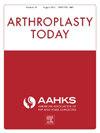全髋关节置换术后是否有必要限制活动?系统回顾
IF 1.5
Q3 ORTHOPEDICS
引用次数: 0
摘要
背景关于全髋关节置换术(THA)术后活动限制的适当程度仍缺乏通用指南。本系统性综述旨在评估放宽全髋关节置换术后活动限制是否会影响植入物存活率、运动恢复、患者满意度和功能性健康结果。方法从 2010 年 1 月 1 日至 2023 年 11 月 22 日,使用目标关键词在 PubMed、Scopus 和 Web of Science 数据库中完成了全面的检索策略。纳入标准包括用英语撰写的随机临床试验、病例对照和队列研究。数据提取的重点是活动水平、康复方案、植入物存活率以及生理和心理结果。初选检索共获得 7420 篇文章,经筛选后纳入 28 项研究。结果重返运动场的结果显示出显著的差异性(20%-98.5%)。大多数研究报告称,高运动量患者的存活率有所提高。高运动量患者的全因翻修率为 0.9%-8.57%,无菌性翻修率为 0.4%-5.7%。低活动量参与者的全因翻修率为 0.7%-3.4%,无菌性翻修率为 0.0%-2.1%。活动量与脱位率之间没有明显的关联。结论目前的关节置换术文献表明,THA术后参与高活动水平的患者与参与低活动水平的患者相比,植入物存活率相似或有所提高。然而,还需要高质量的前瞻性研究来提供循证指南。应鼓励患者在了解自身局限性和风险的情况下,参加自己舒适程度的活动。本文章由计算机程序翻译,如有差异,请以英文原文为准。
Are Activity Restrictions Necessary After Total Hip Arthroplasty: A Systematic Review
Background
There remains a lack of universal guidelines regarding the appropriate level of postoperative activity restrictions following total hip arthroplasty (THA). This systematic review aims to assess whether the liberalization of postoperative activity restrictions following THA impacts implant survivorship, return to sport, patient satisfaction, and functional health outcomes.
Methods
A comprehensive search strategy was completed across PubMed, Scopus, and Web of Science databases using targeted keywords from January 1, 2010, to November 22, 2023. Inclusion criteria included randomized clinical trials, case-control, and cohort studies written in English. Data extraction focused on activity levels, rehabilitation protocols, implant survivorship, and physical and psychological outcomes. The primary search yielded 7420 articles, with 28 studies included after screening.
Results
Return to sports outcomes demonstrated notable variability (20%-98.5%). Most studies reported improved survivorship in high-activity patients. High-activity participants had all-cause revision rates of 0.9%-8.57% and aseptic revision rates of 0.4%-5.7%. Low-activity participants had all-cause revision rates of 0.7%-3.4% and aseptic revision rates of 0.0%-2.1%. There was no clear association between activity level and dislocation rates. Positive associations between post-THA activities and improved mental health and patient satisfaction were observed.
Conclusions
The current arthroplasty literature demonstrates that patients engaging in high-activity levels after THA exhibit similar or improved implant survivorship rates compared to patients participating in low-activity levels. However, high-quality prospective studies are needed to provide evidence-based guidelines. Patients should be encouraged to partake in activities at their own comfort levels with an understanding of their own limitations and risks.
求助全文
通过发布文献求助,成功后即可免费获取论文全文。
去求助
来源期刊

Arthroplasty Today
Medicine-Surgery
CiteScore
2.90
自引率
0.00%
发文量
258
审稿时长
40 weeks
期刊介绍:
Arthroplasty Today is a companion journal to the Journal of Arthroplasty. The journal Arthroplasty Today brings together the clinical and scientific foundations for joint replacement of the hip and knee in an open-access, online format. Arthroplasty Today solicits manuscripts of the highest quality from all areas of scientific endeavor that relate to joint replacement or the treatment of its complications, including those dealing with patient outcomes, economic and policy issues, prosthetic design, biomechanics, biomaterials, and biologic response to arthroplasty. The journal focuses on case reports. It is the purpose of Arthroplasty Today to present material to practicing orthopaedic surgeons that will keep them abreast of developments in the field, prove useful in the care of patients, and aid in understanding the scientific foundation of this subspecialty area of joint replacement. The international members of the Editorial Board provide a worldwide perspective for the journal''s area of interest. Their participation ensures that each issue of Arthroplasty Today provides the reader with timely, peer-reviewed articles of the highest quality.
 求助内容:
求助内容: 应助结果提醒方式:
应助结果提醒方式:


